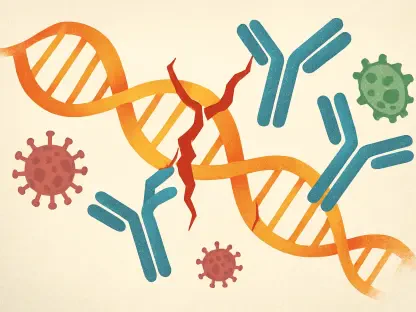Clustered Regularly Interspaced Short Palindromic Repeats (CRISPR) is such an innovative medicine, that it seems like something straight out of a science fiction novel. This gene editing technology allows scientists to precisely target spots in our DNA to fix mutations or stop disease-ridden parts of the genome. It is already proving itself incredibly useful through effects such as gene knockout, knock-in, gene activation or repression, and genomic diagnostic screening. Even though it is still sparking some pretty heated debates, it is undeniably showing tremendous potential to address various health problems.
In this article, we will take a look at some of the latest studies that show some of the progress CRISPR has made possible.
Crispr and Cancer Cell Therapy
A story by the Stanford Report announced a new study that has introduced a CRISPR tool that could make cancer treatments much more effective. This tool, known as MEGA, uses CRISPR to make temporary changes to RNA, which is safer than making permanent changes to DNA. The researchers used MEGA to improve CAR T cell therapy, a treatment that helps the immune system fight cancer but has had trouble with solid tumors. By adjusting the RNA in the T cells, MEGA helps them use energy more efficiently, so they do not tire out as quickly and can keep attacking tumors for longer. In tests, these CRISPR-enhanced cells were much better at shrinking tumors than traditional treatments. Plus, the changes can be turned on or off with a drug, adding an extra safety feature. This new CRISPR method shows great promise for making cancer therapies safer and more effective.
Crispr Against Primary Glioblastoma
Genetic Engineering and Biotechnology News shared that scientists have found a new way to treat a type of brain cancer called glioblastoma. They are using a technique based on gene editing, called “genome shredding,” to target and destroy the cancer cells. The unique genetic patterns of glioblastoma cells are different from normal cells and are found in parts of the genome that do not make proteins.
By directing CRISPR to these special spots, they can cut the DNA of cancer cells and eliminate them. It appears to only affect diseased cells, avoiding healthy ones, which is the most important part of this groundbreaking story. Unfortunately, there are still some unanswered questions, such as how to deliver CRISPR into cells effectively, but researchers are optimistic they will soon come up with sustainable answers. For now, this new approach promises improved cancer care treatments for glioblastoma and similar tumors.
Can CRISPR Treat UTIs?
On August 15, 2024, Live Science shared an early clinical trial that suggests that viruses equipped with the gene-editing tool CRISPR may one day treat urinary tract infections (UTIs).
Scientists would apply this experimental treatment together with traditional antibiotics. However, they need to test it further before moving to clinical use.
The treatment uses bacteriophages and viruses to infect bacteria and is under scrutiny as a potential alternative to conventional antibiotic drugs.
Bacteriophages can zero in on bacteria to attack them. In this case, it was E. coli, the leading culprit behind the pesky UTI. When the CRISPR system attaches to the bacteria, it cuts the bacterial DNA at specific points. This makes it hard for microorganisms to survive and multiply.
In the early clinical trial, the treatment quickly reduced the bacteria in the patient’s urine, and many saw their symptoms disappear within a week. Thankfully, the combination therapy did not cause any serious side effects, and the bacteria did not become resistant during the probing. But this was just the first phase, focusing on safety and dosage. We still need more research to really confirm how effective and safe it is. If future tests keep showing positive results, this new approach could become a great tool for treating UTIs and other infections within the next five to ten years.
Gene Editing Takes on High Cholesterol
Gene editing could also deter the epidemic of high cholesterol, the number one risk factor for heart disease and stroke. Right now, scientists are testing this in people with a rare genetic condition that causes very high levels of cholesterol. The initial findings show great potential and indicate that gene editing could be a new method for reducing “bad” cholesterol.
The researchers in this study used a particular kind of CRISPR called base editing, which allowed them to make small changes to the DNA code. They focused on a gene called PCSK9. It plays a leading role in triggering the production of “bad” LDL cholesterol. Instead of taking cells out of the body, they delivered a CRISPR base-editing tool directly to the liver. By doing so, they were able to make specific changes to the PCSK9 gene to help lower cholesterol levels. Out of 10 patients who were treated, some saw their LDL cholesterol levels drop significantly—by up to 55%.
This approach could provide a one-time treatment for people with high cholesterol, especially those who struggle with regular medication. It might also be useful for people who do not have a genetic condition but are at risk for heart disease.
There are still many questions. We do not know what the long-term effects are or if there could be unintended changes in the DNA. More research and testing are needed to ensure its safety and effectiveness.
Final Thoughts
The very potential of CRISPR and other gene-editing technologies is exciting. It is too early to say it is revolutionizing health solutions, but it does show how invaluable advancements in biopharmaceuticals are. Will gene editing lead to new, precise, and hopefully more accessible treatments? We hope so. With the potential to make precise changes to our genes, which can greatly benefit our health. Still, we must proceed with caution, because scientists have raised concerns of undesired alterations in the genome, leading to unexpected or harmful consequences. While genome researchers believe they are making progress in detecting and reducing these risks, off-target effects are still a challenge. To ensure that these technologies are safe to use, it is crucial to invest in further research. As we move forward, we must carefully manage the risks of these tools while fully leveraging their potential to treat diseases effectively.









